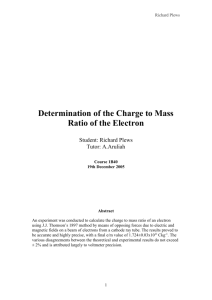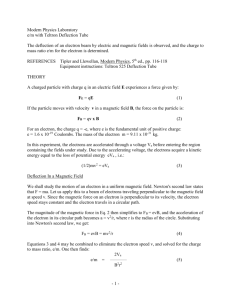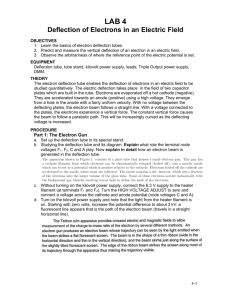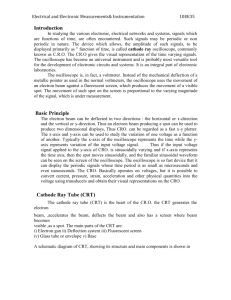Femscan – The development of the image dissector
advertisement
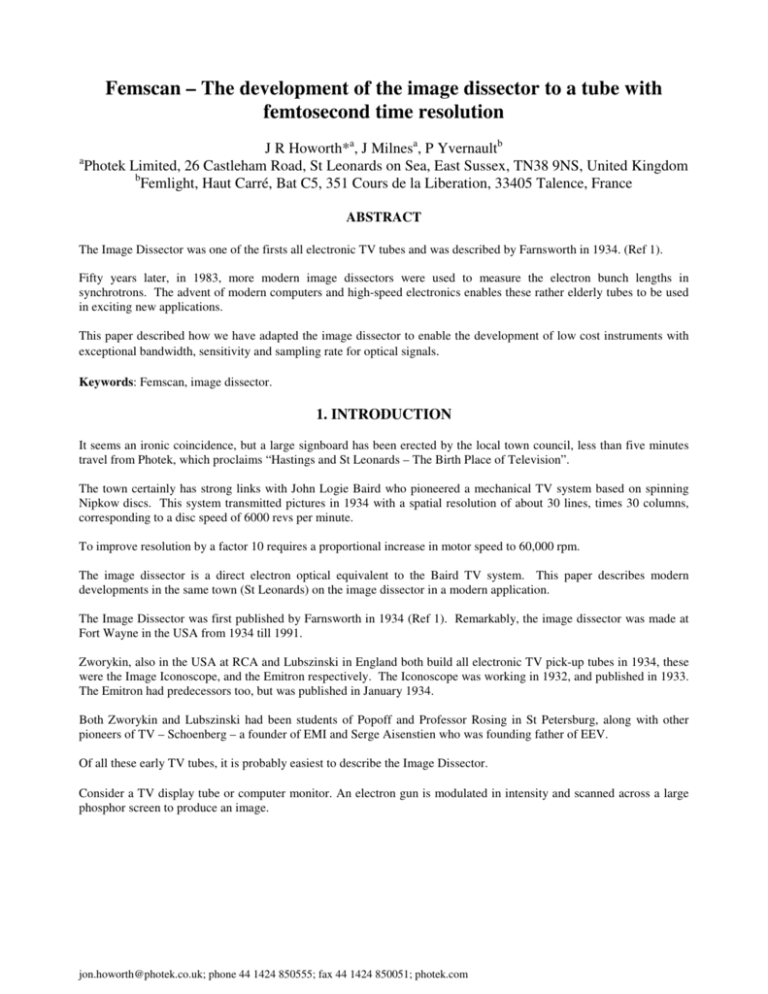
Femscan – The development of the image dissector to a tube with femtosecond time resolution a J R Howorth*a, J Milnesa, P Yvernaultb Photek Limited, 26 Castleham Road, St Leonards on Sea, East Sussex, TN38 9NS, United Kingdom b Femlight, Haut Carré, Bat C5, 351 Cours de la Liberation, 33405 Talence, France ABSTRACT The Image Dissector was one of the firsts all electronic TV tubes and was described by Farnsworth in 1934. (Ref 1). Fifty years later, in 1983, more modern image dissectors were used to measure the electron bunch lengths in synchrotrons. The advent of modern computers and high-speed electronics enables these rather elderly tubes to be used in exciting new applications. This paper described how we have adapted the image dissector to enable the development of low cost instruments with exceptional bandwidth, sensitivity and sampling rate for optical signals. Keywords: Femscan, image dissector. 1. INTRODUCTION It seems an ironic coincidence, but a large signboard has been erected by the local town council, less than five minutes travel from Photek, which proclaims “Hastings and St Leonards – The Birth Place of Television”. The town certainly has strong links with John Logie Baird who pioneered a mechanical TV system based on spinning Nipkow discs. This system transmitted pictures in 1934 with a spatial resolution of about 30 lines, times 30 columns, corresponding to a disc speed of 6000 revs per minute. To improve resolution by a factor 10 requires a proportional increase in motor speed to 60,000 rpm. The image dissector is a direct electron optical equivalent to the Baird TV system. This paper describes modern developments in the same town (St Leonards) on the image dissector in a modern application. The Image Dissector was first published by Farnsworth in 1934 (Ref 1). Remarkably, the image dissector was made at Fort Wayne in the USA from 1934 till 1991. Zworykin, also in the USA at RCA and Lubszinski in England both build all electronic TV pick-up tubes in 1934, these were the Image Iconoscope, and the Emitron respectively. The Iconoscope was working in 1932, and published in 1933. The Emitron had predecessors too, but was published in January 1934. Both Zworykin and Lubszinski had been students of Popoff and Professor Rosing in St Petersburg, along with other pioneers of TV – Schoenberg – a founder of EMI and Serge Aisenstien who was founding father of EEV. Of all these early TV tubes, it is probably easiest to describe the Image Dissector. Consider a TV display tube or computer monitor. An electron gun is modulated in intensity and scanned across a large phosphor screen to produce an image. jon.howorth@photek.co.uk; phone 44 1424 850555; fax 44 1424 850051; photek.com The image dissector reverses the procedure. A large photocathode produces an electron image, which is modulated in intensity according to black/white/grey. This image is then scanned past a small electron detector, so that the output currently produces a signal proportional to light intensity, and corresponds to position on the photocathode image according to the scan. Both the TV tube and the image dissector are capable of extremely high spatial resolution. In modern parlance, the image dissector easily achieves 10 or 20 mega pixels – it would not be hard to exceed these figures. With an electron multiplier, it is easy to detect a single photoelectron with an image dissector. However, as the image dissector only views one pixel at a time, the sensitivity is generally inversely proportional to the number of pixels required. A mega pixel resolution means that only one millionth of the available light is utilised. The tube was never used for commercial broadcast TV. Presumably, the actors would have got too hot under the arc lights needed to televise the scene. The Image Dissector was used for a number of applications, such as character recognition and celestial navigation, where the superb spatial resolution was a key factor (Ref 2-5). 1.1 The Image Dissector as A Detector of Fast Phenomena Russian built image dissectors were used by C J Zlin to measure electron bunch lengths in synchrotrons (Ref 6-7). In these experiments, the dissector was locked to one sixteenth of the fundamental synchrotron frequency, which was 500 MHz. The image was therefore deflected past the electron deflector at 31.25 MHz. Applying a quasi – DC ramp to this at 50 Hz allows the intensity of Cerenkov emission from electrons in the synchrotron to be monitored with a time resolution of about 50 ps. Obviously each sweep has potential information about 16 bunches. For 31.25 MHz and a time resolution of 50 ps corresponding to 20 GHz, means that a spatial resolution of about 650 pixels is necessary. Therefore electron bunches are sampled at 650 divided by factor 16, so perhaps one over 40 photon utilisation. Obviously, a dissector used in line scan mode is much more efficient than when used in a raster scan (two-dimensional) mode. So far, several dissectors have already been implemented on synchrotron facilities. It has also been implemented on time-resolved fluorescence in biophysics as well as in solid state physics experiments (Ref 10). It is within the Centre Lasers Intenses et Application (CELIA) that emerged the idea of developing and commercialising what would become the FEMSCAN. 1.2 FEMSCAN Concept In 2003, we at Photek were approached by Messrs Phillippe Metivier and Phillippe Yvernault to see if it was possible to design an image dissector especially adapted for vastly improved scan rates and time resolution. The goals were several hundred MHz and the sub-picosecond time resolution. The starting point of this design was our Photochron 5 Streak Tube with proven sub-picosecond time resolution and 500 MHz synchro scan capability (Ref 8-9). The focussed electron image of a slit projected onto the photocathode is swept past a mechanical slit aperture to the electron multiplier. The deflection speed is derived from the speed of the voltage ramp applied to the deflector plates, and the deflection sensitivity of the deflection plates (mm/volt). For a sinusoidal deflection voltage generator, the rate of change of voltage with time (dv/dt) is proportional to both frequency and amplitude of the deflection sensitivity. Consequently the connections to the deflector plates need to be jon.howorth@photek.co.uk; phone 44 1424 850555; fax 44 1424 850051; photek.com designed to cope with extreme voltage, and have low inductance and capacitance to cope with high voltage and frequency operation. Typical operating conditions enable deflection speeds of 109 cm/sec at 80 MHz. This corresponds to a time resolution of less than 3 ps with a 30 micron wide slit. Higher synchronous scan rates or deflection voltages allow sub-picosecond time resolution. The time resolution is also a function of the electric field at the photocathode and other electron – optical properties (Ref 9). For this reason, conventional streak tubes are usually operated at 10-15 kV, with a large proportion of this field concentrated near the photocathode. A secondary reason is that the optical gain of normal streak tubes with phosphor screen output increases linearly with voltage. At around 15 kV, a modern 12-bit CCD camera coupled to the output of a streak tube is able to count each photoelectron. A distinct disadvantage of operating at such high voltage is that deflection sensitivity is inversely proportional to overall voltage. Another significant factor is that the optimal detection efficiency of an electron multiplier is typically only a few hundred volts. Both Beryllium/copper dynodes and microchannel plates have peak detection efficiency at electron input energy circa 300 Volts. Operationally, it is convenient to run both the deflection section and the electron multiplier anode close to zero volts. The FEMSCAN was therefore designed to operate with the cathode at a negative voltage equal to the optimal electron input energy to the electron multiplier (e.g. – 300 Volts) summed with the voltage needed to operate the electron multiplier (e.g. –3000 Volts for 106 gain). Thus the cathode is at –3300 Volts and the deflection section close to ground. The section between deflection region and electron multiplier decelerates the electrons to 300 eV for optimum detection efficiency. There is a slight mechanical advantage, in that this arrangement allows the overall length of the tube to be reduced without compromising the deflection sensitivity. 1.4 Results on Femscan Tubes Several Femscan tubes have been built and tested in prototype cameras. Typical results obtained with the Femscan system are shown in the following. 1.5 Operating FEMSCAN FEMSCAN is usually used on an experiment such as depicted on figure [1]. A femto or picosecond laser illuminates the object under test. Normally this object would radiate at the same or another wavelength with a timescale ranging from ps to ns. The deflection voltage is a sine wave built up from an optical signal in order to limit the jitter due to the phase and amplitude modulations of the laser. jon.howorth@photek.co.uk; phone 44 1424 850555; fax 44 1424 850051; photek.com Figure 1: Time-resolved experiment with FEMSCAN Operating frequencies are usually around 80 MHz which corresponds to typical Ti:Sa laser frequency. For long lifetime experiments a pulse picker is sometimes added in order to decrease the repetition rate. FEMSCAN samples the temporal waveform at the time when photoelectrons travel through the deflection plates while the deflection voltage crosses the zero level. Delaying this zero crossing point with respect to the time of arrival of photoelectrons makes the FEMSCAN scan the temporal waveform. Two means of delaying is implemented on the FEMSCAN. One consists in offsetting the deflection voltage, which allows real-time control, the second of shifting the phase of the deflection voltage for photon counting application. Real-time: in that mode, a low frequency ramping voltage is summed to the deflection voltage. By consequence, the zero crossing point is varying at the same frequency as the ramping voltage. Thus, the temporal waveform is scanned by this low frequency and can be displayed on an oscilloscope. Current FEMSCAN has a 50 Hz and 500 Hz ramp generator and can be extended to 5kHz. The ramp can also be built up from a 0-5 V external ramp whatever the frequency. The amplitude of the ramp fixes the scan range and can be varied. This mode is for instance very useful to align a set up or stabilise a laser system since the waveform is displayed with a refreshing rate of 50 Hz. With a 50 Hz ramp frequency, a 3 ps signal has a 13 µs trace. Photon counting: in that mode, the sampling is numerically controlled. The phase of the deflection voltage can either be controlled numerically or by an analogue signal. The output of FEMSCAN is then connected to a photon counter figure 1. Then data can be stored and displayed on computer. The phase shift can be as large as 8 ns. The temporal resolution is maintained all along the scan range. The count time and time step can be totally parameterised. jon.howorth@photek.co.uk; phone 44 1424 850555; fax 44 1424 850051; photek.com There are three outputs on the FEMSCAN. One is directly to the signal from the anode of the electron multiplier. The load resistance of the oscilloscope or any device coupled with fixes the bandwidth and level of the signal. The second output is the anode signal amplified by a transimpedance amplifier with 1MHz bandwidth and a gain of -50kV/A. Finally, the third output prescaled the signal from the anode to match major photon counter input. 2.RESULTS 2.1. Dynamic The FEMSCAN has been tested with a Ti:Sa laser at the frequency 76.16 MHz. The laser delivers 200 fs pulses at 800 mW at 780 nm. A glass plate extracts 4% of the signal to illuminate an optical constant fraction discriminator. Then, density filters are placed in front of the FEMSCAN to attenuate the signal to 1 nW at the photocathode. The optical signal is collected with a single mode optical fibre to ensure minimum spot size and reduce the ambient. The figure 2 represents the response of FEMSCAN to a fs pulse in log scale. A dynamic of five decades has been reached between the maximum and ambient noise. The queue after the pulse is due to the scattering of the laser in density filters and beam splitters. 10000000 1000000 10^5,18 Counts 100000 10000 1000 Beam stop in front of FEMSCAN 100 Ambient noise 10 1 0 100 200 300 400 500 600 700 800 Time ( ps) Figure 2: Dynamic of FEMSCAN The FWHM of the pulse is 10 ps which is larger than the temporal resolution of the tube. The temporal spreading is mainly due to the chromatic dispersion in the fibre: a fs pulse has a wide spectrum. 2.2 Temporal Resolution Prior to determining the resolution, we had to validate the software and the phase shifter. We implemented an interferometer to perform some pulse pair experiments. A micro controller stage has been used to delay one pulse with respect to the other. A double Gaussian fit is applied to the data to determine the delay between pulses, figure 3. The experiment was done coupling with an optical fibre, hence a temporal resolution of 10 ps. jon.howorth@photek.co.uk; phone 44 1424 850555; fax 44 1424 850051; photek.com 12000 10000 Counts 8000 6000 count Fit 4000 2000 0 -150 -100 -50 0 -2000 50 100 150 Time (ps) Figure 3: Pulse pair experiment - Delay between pulses determine the optical path difference We performed five measurements increasing the optical path difference by 2 mm at each measurement. We did a scan with a 100 ms count time and a 1ps time step. Results are reported on table (1). Optical Path Difference (mm) 0 2 4 6 8 Absolute Delay (ps) 6,5 13,2 19,9 26,2 32,3 Relative Delay (ps) 0 6,6 6,7 6,3 6,1 Table 1: Optical path difference and measured delay between pulses The mean delay measured was 6.44 ps with a standard deviation of 270 fs. This must be compared to the 6.66 ps expected value, hence a 160 fs error. This deviation can be explained by the misalignment of mirror and fitting error. Most important, the experiment has validated the software and the phase control. The next step has been to optimise the temporal resolution. To determine the temporal resolution of the FEMSCAN, we must get rid of the optical fibre Light is focused on the photocathode with a 20 mm achromatic doublet. The impulse response of the FEMSCAN is depicted in figure 4. The phase step of the deflection voltage is 700 fs, the count time is 300 ms. The Gaussian fit applied to the data gives 5.0 ps FWHM. jon.howorth@photek.co.uk; phone 44 1424 850555; fax 44 1424 850051; photek.com 800000 Counts 700000 Fit Counts 600000 500000 400000 300000 200000 100000 0 0 5 10 15 20 25 Time (ps) Figure 4: Impulse response of FEMSCAN. Data are fitted with a gaussian. There are four major contributions to the degradation of the temporal resolution: 1. 2. 3. 4. Spot size on the photocathode: it must be as small as possible. Electron optics focusing: optimisation of electrodes voltages. Deflection voltage amplitude. Laser stability and synchronisation jitter. The first three contributions can be analysed and optimised in the real-time mode independently of laser and synchronisation jitter. It has been estimated that the minimum resolution achievable according to them was about 3 ps. The jitter due to synchronisation and laser stability might be of 4 ps (the mean square root of the two giving 5 ps). We did the same experiment 10 times and measured the FWHM with a Gaussian fit. The laser jitter or spot size was a bit worse and the FWHM was around 6 ps. The mean value of the FWHM over the 10 measurements gave 5.95 ps with a standard deviation of 190 fs. REFERENCES 1. 2. 3. 4. 5. 6. 7. 8. 9. 10. P. T. J. Farnsworth, Inst 218, 411 (1934). W. Atwill, W Electronics 33, 88 (1960). N. P. Laverty, IEEE Trans on Aerospace ANE-10, 194 (1967). J. Strong, Applied Optics 6, 179 (1967). J. E. Guidnon and R. M. Kline, Technical Reports 5 & 10 “Development of an On-Line Image Processing System for the line” Computer Systems Laboratory, Washington University (1968). G. S. Brown, V. P. Suller and E. Zimm, E, IEEE Trans on Nuc Sci NS-30, 4 2348-2350 (1983). Zinin E I, Nucl Instr & Methods, 208 pp 439-441 (1983). D. Bowley, J. Beely and M. Pittock, 22nd International High Speed Photography & Photonics, SPIE 2869, 76-81 (1996). J. R. Howorth, I. Phillips and M. Monastryski, 25th International High Speed Photography & Photonics, SPIE 4948, 311-317 (2003). P. Martin et al, "Spectroscopie VUV sub-picoseconde: un détecteur haute cadence et un monochromateur pour impulsions femtosecondes", J. Phys. IV France _108_ (2003)123. jon.howorth@photek.co.uk; phone 44 1424 850555; fax 44 1424 850051; photek.com

